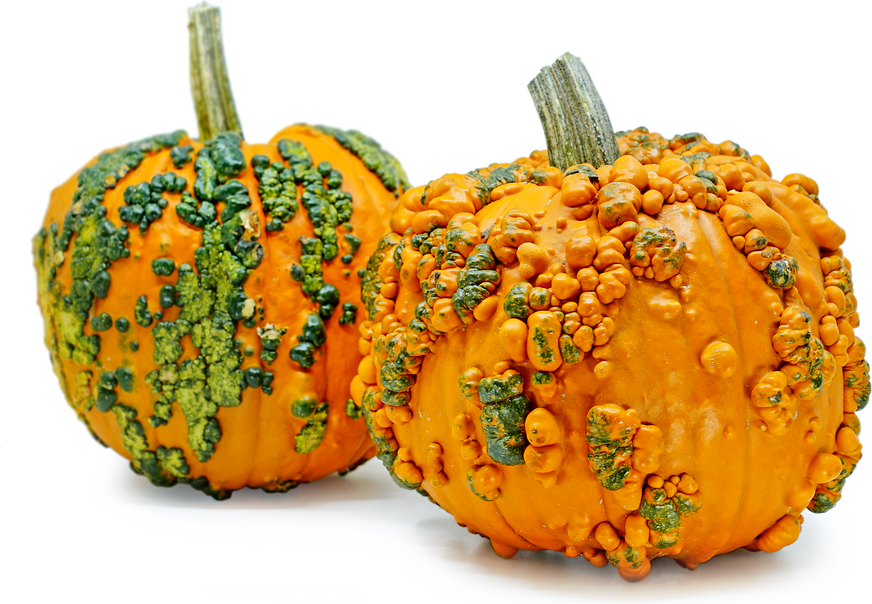


Knucklehead Pumpkins
Estimated Inventory, lb : 0
Description/Taste
Knucklehead pumpkins are small to medium in size, averaging 30 centimeters in height, 25 centimeters in diameter, and weighing about 5.5 to 7 kilograms each. They have an upright, elongated oval shape. Their rind has vertical ridging and matures from dark green to bright orange. This rind is covered in warts, scabs, or bumps connecting to a rough, green-brown angular stem. Some warts may also transform from dark green to orange while others may remain green when mature. Knucklehead pumpkins' flesh is yellow-orange, dense, and thick, containing a central cavity with pulp and flat, cream-colored seeds. When cooked, Knucklehead pumpkins are smooth and tender with a sweet yet mild flavor.
Seasons/Availability
Knucklehead pumpkins are available from late summer to fall.
Current Facts
Knucklehead pumpkins are botanically classified as Cucurbita pepo and are members of the Cucurbitaceae family along with gourds and squash. They are a hybrid variety that grows on trailing vines and are intentionally bred for their unique texture and large, elongated size. They are classified as Superfreak pumpkins due to their large warts and boils, qualities that make them resistant to scratches and bruises. There are many varieties of Knucklehead pumpkins including Frankenstein Scarface, Warty Goblin, Marina di Chioggia, and Galeux Eysines pumpkins. Knuckleheads are primarily an ornamental pumpkin used as a unique fall accent and for carving Halloween jack-o’lanterns. They can also be used in sweet and savory culinary applications.
Nutritional Value
Knucklehead pumpkins, like all pumpkin varieties, are high in vitamin A, supporting vision, immune function, and skin health. Their presence of vitamin C enhances antioxidant properties, helping to boost the immune system and promote collagen production for healthy skin and connective tissues. Tryptophan, an amino acid found in these pumpkins, plays a crucial role in mood regulation and may help improve sleep quality. Knucklehead pumpkins' rich potassium content helps maintain healthy blood pressure levels and supports heart function, while their phosphorus and magnesium contribute to strong bones and energy metabolism. This variety contains copper and iron, essential for red blood cell formation, iron absorption, transporting oxygen in the blood, and preventing fatigue. The presence of zinc in these pumpkins supports immune function, promotes wound healing, and aids in protein synthesis.
Applications
Knucklehead pumpkins are best suited for cooked applications such as baking, roasting, or boiling. They can be cooked and combined with roasted winter vegetables as a side dish, sliced and mixed into green salads, or pureed and blended into soups. Knucklehead pumpkins can also be incorporated into sweet applications like bread, cookies, muffins, tarts, puddings, pies, cakes, and custards. In addition to the flesh, the seeds can be cleaned, roasted, and salted as a crunchy snack. Knucklehead pumpkins pair well with meats such as turkey, sausage, poultry, and beef, eggs, onions, celery, carrots, ginger, garlic, bell peppers, sweet potatoes, tomatoes, pomegranate seeds, arugula, kale, and spices and herbs such as garam masala, paprika, cumin, bay leaves, thyme, and oregano. They will keep for about three months when stored in a cool, dry place.
Ethnic/Cultural Info
Warty pumpkins were not always a popular choice for Halloween and autumnal decor. In the past, consumers preferred smooth-faced pumpkins to purchase for carving. Pumpkins with warts were deemed unhealthy or defective. Farmers would breed out warts to create only smooth pumpkin varieties. As time passed, consumers began searching for more novel and unique varieties to fill the need for creative jack-o’lanterns. Sieger Seed Company recognized the shift in the market and began intentionally breeding varieties with warts and bumps. These pumpkins have an unusual, ghoulish appearance that has become increasingly popular for jack o’lanterns.
Geography/History
Knucklehead pumpkins originated from a specialty line of pumpkins known as Superfreak developed by Siegers Seed Company in Holland, Michigan in 2008. It took over ten generations of cross-breeding to create varieties like the Knucklehead that were completely covered in warts. These pumpkins grow best in warm climates with full sun exposure and daytime temperatures ranging from 21 to 27 degrees Celcius. As a cultivated variety specifically bred to have a bumpy texture, Knucklehead pumpkins must be sown in gardens or produced commercially to attain their warty aesthetic. This novel variety has grown in popularity since the early 2000s, particularly during the Halloween and fall seasons as an alternative to smooth-faced orange pumpkins. Knucklehead pumpkins can be found at specialty grocers, farmers’ markets, and through seed catalogs for home gardening in the United States and Canada.









